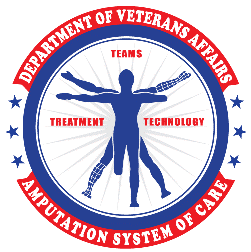Rehabilitation and Prosthetic Services
ASoC: History
 The Veterans Medical Programs Amendments of 1992 (Public Law 102-405) identified Veterans with amputations as a special disability group and emphasized the importance for VHA to provide the highest quality of care to this patient population. The Federal Advisory Committee on Prosthetics and Special Disabilities Programs was also chartered to review VA’s programs responsible for amputation prevention and the rehabilitation and prosthetic care of those with amputations. The Veterans’ Health Care Eligibility Act of 1996, (Public Law 104-262), Section 104 required VA to maintain its capacity to care for the needs of patients with amputations, consistent with the level at the time of passage of the legislation. As a result of the enactment of these laws and the formation of the Federal Advisory Committee on Prosthetics and Special Disability Programs, VA has developed an extensive program for amputation rehabilitation.
The Veterans Medical Programs Amendments of 1992 (Public Law 102-405) identified Veterans with amputations as a special disability group and emphasized the importance for VHA to provide the highest quality of care to this patient population. The Federal Advisory Committee on Prosthetics and Special Disabilities Programs was also chartered to review VA’s programs responsible for amputation prevention and the rehabilitation and prosthetic care of those with amputations. The Veterans’ Health Care Eligibility Act of 1996, (Public Law 104-262), Section 104 required VA to maintain its capacity to care for the needs of patients with amputations, consistent with the level at the time of passage of the legislation. As a result of the enactment of these laws and the formation of the Federal Advisory Committee on Prosthetics and Special Disability Programs, VA has developed an extensive program for amputation rehabilitation.
The majority of Veterans with amputations treated within VHA remain those resulting from diabetes or peripheral vascular disease (PVD). This type of amputation generally occurs in the aging Veteran and is associated with numerous comorbidities such as cardiovascular disease, hypertension, end-stage renal disease with dialysis, and arthritis. However, the number of Veterans with traumatic amputation due to combat is increasing. The Global War on Terror (GWOT), Operation Enduring Freedom (OEF), and Operation Iraqi Freedom (OIF) have introduced a new generation of Veterans into VA’s healthcare system. This group tends to be young and desire to return to a full, active lifestyle that demands VA develop a consistent approach in providing these Veterans the latest in treatment, technology, and rehabilitation techniques. Although the number of these combat related amputations is relatively small compared with those associated with disease, both groups have equal needs for quality programs, comprehensive services, and life-long care. To meet these needs VA has enhanced the current system of care moving from a disease model to a wellness model and assuring equal access for all Veterans.
- Department Of Veterans Affairs Amputation System Of Care: 5 Years Of Accomplishments And Outcomes (Journal of Rehabilitation Research & Development (JRRD) Article)



















